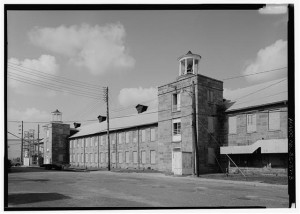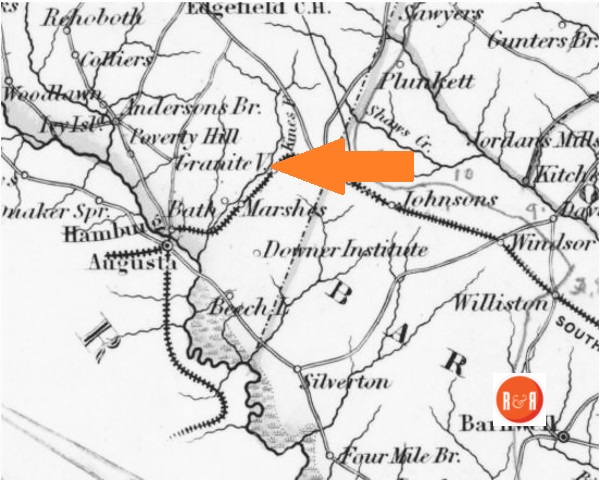City Directories and History: The wealthy contractor – lumberman Daniel Cannon apparently commenced construction of this large two-and-a-half-story wood house
on a high brick basement in 1802, and after his death the structure was completed by his estate some years later for his daughter. The house retains some of its original exterior

Graniteville Textile Mill – Images(s) and information from: The Library of Congress – HABS Photo Collection
elements, including hipped roof and fenestration, and there are splendid Adamesque features on its interior. William Gregg, jeweler and founder of Graniteville Manufacturing Company, the South’s most innovative antebellum industrial facility, lived here from 1838 to 1855. The property has notable Greek Revival additions, including the piazza columns and a Victorian cast-iron fence. A double brick dependency survives northwest of the main house. Mr. Gregg was a long term associate of S.C. banker, Hiram Hutchison of York County, Columbia, Cheraw and Hamberg, S.C. It was Mr. Hutchison who served as Mr. Gregg’s financial manager and business partner until Hiram Hutchison moved to New York City in the early 1850’s. Click on the highlighted Hutchison name above to read an extensive history of his associations and business dealings.
Also see #77 Nassau Street for other housing built by William Gregg.
Information from: The Buildings of Charleston – J.H. Poston – Author, for the Historic Charleston Foundation, 1997
Daniel Cannon prospered as a building contractor, property owner and part-time planter. He was among those who joined Christopher Gadsden under the Liberty Tree and was a member of the Congress of South Carolina in 1775. He was captain of the Cannon Volunteers during the Revolution. Cannon lived on Queen Street next door to the Dock Street Theatre and started construction of a new residence in 1802. Only the basement was completed before his death. Cannon’s daughter Martha finished construction of the house, one of the finest examples of Federal architecture on the Charleston peninsula. After her death, the house was owned by a series of planters, including Henry A. Middleton of Georgetown, before it was acquired by William Gregg in 1838.
William Gregg was born in Virginia and is considered one of Charleston’s outstanding entrepreneurs. Apprenticed to his uncle, he learned watch making and textile spinning in his uncle’s Georgia mill. When England flooded the market with cheap imported goods after the War of 1812, the mill failed. Gregg was then apprenticed to a friend of his uncle who lived in Lexington, Kentucky. When he was twenty-one, Gregg moved to Petersburg, Virginia, where he worked for a silversmith named Blanchard. Three years later, he moved to Columbia, South Carolina, and prospered by importing fancy goods, silver, watches and military paraphernalia. In 1829, he married Marina Jones from Edgefield.
The story is told that Gregg once went on a trip to Iowa and traveled in a coach driven by a white coachman and four horses. The cost of feed in the sparsely populated West forced him to sell two of his horses before he returned to South Carolina. Gregg turned a struggling textile factory in the Edgefield District into a highly profitable enterprise. He moved to Charleston in 1838 and went into business as a jeweler and silversmith with Nathaniel Hayden and his brother H. Sidney Hayden. Hayden, Gregg & Company became the leading supplier of luxury goods and jewelry in Charleston. The partners remained in business until Gregg devoted himself full time to the cotton industry.

Courtesy of the New York J.H. Colton and Company, 1856; from Colton’s Atlas of the World
A man of vision, Gregg understood the economic advantages of having mills located near the cotton fields. In 1844, Gregg toured the textile manufacturers in the North. He wrote a series of articles for the Charleston Courier, advocating that the South end its reliance on agriculture and start investing in manufacturing. The articles were published in pamphlet form and were widely circulated in the 1850s and 1860s through journals such as DeBow’s Review and Hunt’s Merchants’ Magazine.
By 1845, Gregg and several partners had secured a charter from the South Carolina General Assembly and established the Graniteville Manufacturing Company in the Edgefield District. The factory quickly became the most successful textile factory in the entire South. It had 9,245 spindles and a capital base sufficient to hold its own witli northern competitors. Gregg provided a church, library and quality housing for his workers. Medical care was available for a modest fee. He also created what is thought to be the first compulsory educational system, providing teachers and books for children from six to twelve years of age. Parents were fined five cents a day when their children were absent from classes. Gregg was elected to the South Carolina House of Representatives in 1856, where he argued for industrial development. He was a member of the Secession Convention in December 1860 and signed the Ordinance of Secession. The Graniteville mill produced cotton cloth for the Confederacy.
When the Greggs lived in the mansion, the house was still surrounded by water. The family used a boat for exit and entry; crabs used to nibble at the bare toes of the children when they came down to the water’s edge. In the front yard were two palmettos that Mrs. Gregg had raised in doors from seed. The garden was a showplace, and drivers from the city would bring visitors to admire it. Gregg installed handsome rectangular pillars from Graniteville at the entrance to his driveway.
In 1855,Gregg sold the house to John Rutledge, son of the accomplished chief justice. The younger Rutledge married the daughter of eminent Patriot and educator, the Reverend Robert Smith, rector of St. Philip’s Church, and his second wife, Sarah Shubrick. Smith was at St. Philip’s Church for forty tumultuous years and is known for his active participation in the Revolution. He was the first bishop of South Carolina and helped establish the American Episcopal Church. He also started a school that later became the College of Charleston and was its first president. (Courtesy of author and historian, Peg M. R. Eastman – Hidden History of Old Charleston, History Press – 2010)
Other sources of interest: Charleston Tax Payers of Charleston, SC in 1860-61 and the Dwelling Houses of Charleston by Alice R.H. Smith – 1917 Also see Gregg’s Charleston Textile Mill site on Drake Street.

Image of the Charleston Battery taken in ca. 1960 – photographer Neilson. Courtesy of the FCHS.

Stay Connected
Explore history, houses, and stories across S.C. Your membership provides you with updates on regional topics, information on historic research, preservation, and monthly feature articles. But remember R&R wants to hear from you and assist in preserving your own family genealogy and memorabilia.
Visit the Southern Queries – Forum to receive assistance in answering questions, discuss genealogy, and enjoy exploring preservation topics with other members. Also listed are several history and genealogical researchers for hire.
User comments welcome — post at the bottom of this page.
The HCF may also have additional data at: Past Perfect and further research can be uncovered at: Charleston 1861 Census Schedule
Please enjoy this structure and all those listed in Roots and Recall. But remember each is private property. So view them from a distance or from a public area such as the sidewalk or public road.
Do you have information to share and preserve? Family, school, church, or other older photos and stories are welcome. Send them digitally through the “Share Your Story” link, so they too might be posted on Roots and Recall.
Thanks!





